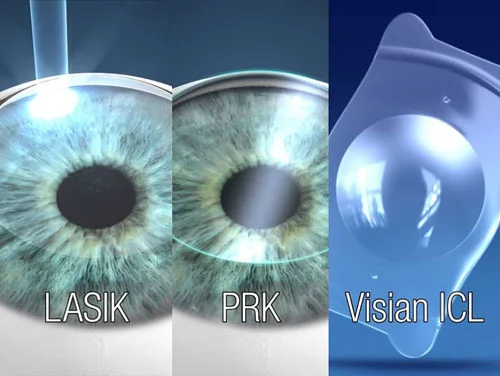Implantable Contact Lens (ICL) treatment provides an alternative solution to patients unsuitable for LASIK eye surgery by providing similar results but without the need to remove corneal tissue. This allows patients previously unable to go for corrective eye surgery due to thin corneas or an extremely high refractive error for myopia, hyperopia or astigmatism to obtain visual …
Implantable Contact Lens (ICL) treatment provides an alternative solution to patients unsuitable for LASIK eye surgery by providing similar results but without the need to remove corneal tissue. This allows patients previously unable to go for corrective eye surgery due to thin corneas or an extremely high refractive error for myopia, hyperopia or astigmatism to obtain visual clarity without the need for laser eye surgery.

The Dr Natasha Lim Eye Centre provides ICL through the US FDA approved Visian Implantable Contact Lens. The Visian ICL is able to correct myopia of -3.0 D to -20.0 D. Toric models of Visian ICL can correct both myopia and astigmatism simultaneously. This allows patients suffering from astigmatism to also expect total spectacle freedom post-operation.
The Visian ICL manufacturers also refer to ICL as Implantable Collamer Lens which are soft, flexible gel-lens made out of a collagen copolymer material and its name is derived from combining collagen and polymer. This collamer is biologically inert and has no reaction with the rest of the eye when implanted. Because of the lack of requirement of the removal of corneal tissue which means the operation is reversible, the ICL procedure has become a popular alternative to LASIK and PRK surgery. It has been in use for more than a decade worldwide and with more than 100,000 ICL successfully ICL implantation without any complications being accomplished worldwide, published clinical trials with long term results have determined Implantable Contact Lens to be both safe and effective and thus in December 2005, the US FDA approved Visian ICL as a treatment for myopia. LASIK is a non-invasive surgery which simply re-shapes the outer aspect of the cornea to treat myopia, hyperopia, astigmatism and presbyopia.

During the ICL surgery process, the ICL is surgically implanted inside the eye where it resides behind the iris muscle and in front of the crystalline lens permanently. The ICL requires no maintenance after the ICL surgery and functions exactly like contact lenses in improving visual clarity. For patients, ICL provides permanent freedom from glasses and contact lenses
At the Dr Natasha Lim Eye Centre, the ICL procedure is performed as a day surgery only while the patient is under local anaesthesia. At which both eyes are operated on at the same time. The flexibility of the ICL enables the lens to be rolled for insertion into the soft silicone tip of the micro incision injector through an incision as small as 2.5 millimetres which negates the need for stitches. The surgery is pain-free and usually takes around 10 minutes per eye in the hands of an experienced ophthalmologist. Unlike Lasik or other corrective surgery, most patients regain use of their eyes immediately and only take around a day or a night to recover from the surgery. This allows patients to continue with their lives painlessly the day following the surgery. Patients are cautioned against driving home and are to regularly visit the Eye centre for checkups to monitor the implants for several months.
ICL Surgery
In the past, old versions of ICLs required a peripheral iridotomy laser procedure before the surgery to prevent the onset of glaucoma postoperative. Dr Natasha Lim utilises the latest Visian ICLs with CenterFLOW which has central KS-Aquaport, thus removing the need for peripheral iridectomy which reduces procedure time and enhances overall patient experience. With the use of this central port, eye pressure remains stable while refractive outcomes match those of previous lens models.
The ideal candidates for ICL surgery include those who:
- Suffer from moderate to high myopia (nearsightedness) of -3.00 to -20.00 diopters
- Suffer from hyperopia up to +12.00 (long-sightedness) diopters
- Suffer from astigmatism up to -5.00 dioptres
- Are not good candidates for LASIK because they have thin corneas or abnormal corneal curvature
- Aged 21 – 45 years old (FDA approved age group for ICL in the US)
However, not everyone is suitable for ICL and a person is not a good candidate for ICL if they:
- Have large pupils. If one’s pupil dilates in low lighting conditions to a size that is larger than the size of the ICL, one has a higher risk of experiencing visual disturbances after surgery that may affect one’s ability to function comfortably or normally under such conditions (e.g., while driving at night).
- Have glaucoma
- Have Cataract
- Are over the age of 45 years old. ICLs are not FDA approved for people above 45 years of age. The internal environment of the human eye starts to change around 45 years of age and ICL implanted may not be in a stable environment
Even though ICL surgery has been proven to be very safe, there are some risks associated with invasive eye surgeries in general such as:
- the development of cataracts which could occur if the natural lens is touched by the ICL during the surgery,
- increased rate of endothelial cell loss from the back surface of the cornea, and
- glaucoma (increased pressure inside the eye).
One of the key advantages of ICL surgery is reversibility. If any signs of a negative reaction to ICL implantation are observed post operation, the ICL can be removed relatively easily. More commonly, revision surgery involves replacing one ICL with a smaller or larger lens to improve the fit in the eye, or repositioning the ICL within the eye. If revision surgery is required, the recovery is the same and as quick as the original surgery.

LASIK vs ICL
Even though LASIK is the more popular option which is proven and safe, only 95% of people are suitable for it. This is because it is dependent on the corneal parameters taken during the LASIK assessment. Since ICL surgery does not involve the cornea, it makes it the safer and better choice for those who are unsuitable for LASIK.
Even though the risks associated with ICL are very low, it is still a truly invasive intraocular procedure which means that potential complications are much more severe than LASIK. The most serious complication associated with ICL is an infection within the eyeball which results in permanent loss of visual acuity. Infection of the intra-ocular tissues or endophthalmitis are extremely rare but still pose a potentially sight-threatening complication. Some of the other potential problems include, but are not limited to, retinal detachment, cataract, corneal decompensation and glaucoma.






